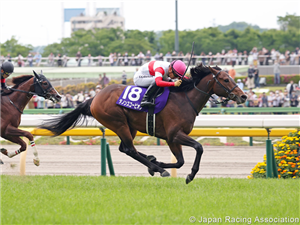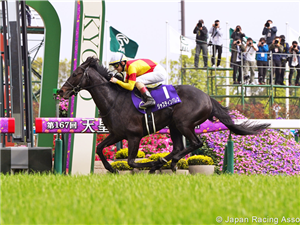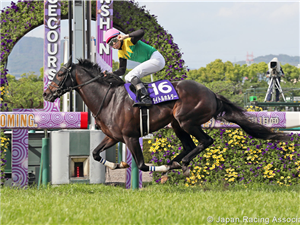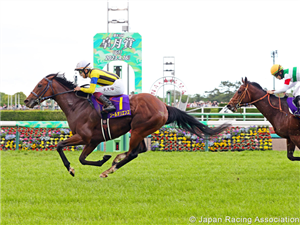The international gala that is the Japan Cup is upon us.
On Sunday, Nov. 26, Tokyo Racecourse will see horses representing four nations vie for one of the biggest purses in the world of horseracing. Recent years have seen the prize money rise staggeringly and the total purse of the Japan Cup invitational now stands at 648 million yen (over $5.6 million), with 300 million yen going to the winner of the 37th running of the 2,400-meter turf event.
The Japan Cup was originally started largely in an effort to help raise the level of Japanese racing and it, together with many other efforts by Japan’s horsemen, now sees Japan compete highly competitively on an international level. In fact, the past 11 Japan Cup winners have come from the home team and, in the past 10 runnings, Japanese runners have managed to sweep the top three spots. This year, only four horses – Guignol and Japan Cup repeater Iquitos from Germany, Idaho from Ireland, and Caulfield Cup winner Boom Time from Australia – are here to try to loosen the iron grip Japanese horses have maintained on the Japan Cup. Scheduled riders for the overseas raiders are Filip Minarik, Daniele Porcu, Ryan Moore, and Cory Parish.
Not only is the competition formidable as seen from abroad, many at home are reluctant to take on what is often one of the toughest lineups of the year. Only 19 horses, including the four invitees from abroad, were nominated for the race and, now with the withdrawal of Tante Alegria last week, all will gain a berth. Those 18 will include three Japanese Derby winners and two double Grade 1 winners in addition to the field’s standout – Kitasan Black, winner of last year’s Japan Cup. The pride of singer Saburo Kitajima is aiming for his seventh Grade 1 victory and currently tops the lot for earnings with 712 million yen to his name.
The Tokyo 2,400 meters is also the venue for two of the 3-year-old classics – the Tokyo Yushun (Japanese Derby) and Yushun Himba (Japanese Oaks). The race starts before the grandstand at the top of the slope and continues 350 meters to the first turn. The course is known for its lengthy 525-meter stretch, a final push home that has, for many a jockey, seemingly “lasted forever.”
Though early times are often slow, a good deal of early speed in the race often picks up the pace considerably. Wire-to-wire wins like Kitasan Black’s last year are rare. The draw is considered fair across the field.
The Japan Cup is the 11th and final race on the Sunday card at Tokyo Racecourse. Post time is 15:40 local time. Here’s a look at some of the expected top choices.
Kitasan Black: Despite his performance in the Takarazuka Kinen, this 5-year-old son of Black Tide returned to the track after the summer and did not disappoint in the Tenno Sho (Autumn). Now, with only two more starts scheduled before he is to be retired, his fans are more behind him than ever. Last year he went wire to wire to beat the field by 2 1/2 lengths over Sounds of Earth. In the Tenno Sho (Autumn), he hit the gate and came out askew, but quickly gained his feet, traveled a ground-saving inside track over the sloppy going, was in the lead by the straight and held off an advancing Satono Crown to win by a neck. The challenge by the 3-year-olds will be strong this year but this six-time Grade 1 winner shows no signs of being ready to relinquish his sovereignty.
Rey de Oro: Of the two 3-year-olds that pose a threat to the more established runners this year, Rey de Oro, a son of King Kamehameha, is considered the greater threat of the two classy youngsters being fielded by trainer Kazuo Fujisawa. Rey de Oro is currently five for six and this year’s Japanese Derby winner. In the Derby, he beat Suave Richard to the line and the latter just bested a field of older horses in the Copa Republica Argentina, a Grade 2 over 2,500 meters at Tokyo. The only black mark on Rey de Oro’s career was the Satsuki Sho (Japanese 2000 Guineas), in which he broke late and finished fifth. Last out, he topped Kiseki in the Kobe Shimbun Hai and Kiseki went on to win the Kikuka Sho (Japanese St. Leger). That was two months ago and he’s had enough time to recover. Rey de Oro is a versatile colt with good racing sense. And, being Miho-based, compared to Ritto, it’s only a hop to the racetrack. He’ll be saddled with 55kg and Christophe Lemaire, who currently leads Japan’s jockeys with 173 wins, is in the saddle.
Satono Crown: The Noriyuki Hori-trained Satono Crown went from the Tenno Sho (Autumn) last year to Hong Kong, where he captured the Hong Kong Vase. The same age as Kitasan Black, the Marju-sired Satono Crown was far ahead in the Tokyo Yushun (Japanese Derby), finishing third to Kitasan Black’s 14th. This year Satono Crown won the Takarazuka Kinen and beat Kitasan Black in doing so. The tables were turned once again in the Tenno Sho (Autumn), but just barely. With an extra furlong this time out, Satono Crown may pose the biggest threat to Kitasan Black. Mirco Demuro, currently the No. 3 rider in Japan with 156 wins, is expected to have the ride. Demuro has won the last two JRA Grade 1s – the Mile Championship and Queen Elizabeth II Cup – and has not missed the top three placings in a JRA Grade 1 since the Victoria Mile in mid-May.
Cheval Grand: In last year’s Japan Cup, both Kitasan Black and runnerup Sounds of Earth had gone directly from the Kyoto Daishoten. This year, four horses are going directly to the Japan Cup from the Kyoto 2,400-meter Grade 2. Cheval Grand is one of them. Third place in his last start, Cheval Grand missed second place in the Japan Cup last year by a mere neck and had the Copa Republica Argentina as his previous start. This year, with a bit more time between races, he may be able to get closer to the top.
Makahiki: The 4-year-old Deep Impact-sired Makahiki won the Tokyo Yushun (Japanese Derby) last year and went on to win the Grade 2 Prix Niel in France before disappointing in the Arc. His four starts this year, two at the top level, two at the Grade 2 level, have reaped him a third, fourth, sixth and fifth. His two starts at Tokyo – the Mainichi Okan and the Tenno Sho (Autumn) – were at 1,800 and 2,000 meters and brought him a sixth and fifth, respectively. This will be his first Japan Cup bid and a return to the Tokyo 2,400 meters will likely prove a plus.
Rainbow Line: Sixth in last year’s Japan Cup after running second in the Kikuka Sho, Rainbow Line surprised as 13th pick when he finished third in the Tenno Sho (Autumn), his best result in his four starts since the 2016 Japan Cup. He was coming off a 4-month layoff and is expected to show improvement. If it comes down to late speed, this son of Stay Gold is a good bet to round out a wager.




